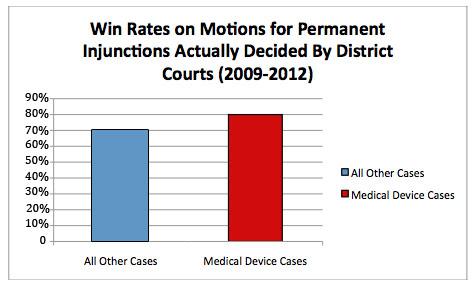 By Orion Armon, IP Litigation practice group, Cooley LLP
By Orion Armon, IP Litigation practice group, Cooley LLP
Since 2009, medical device companies obtained permanent injunctions in 80 percent of cases in which courts ruled on post-trial motions for injunctive relief. The medical device injunction win rate was ten percentage points higher than the win rate for patent owners in other technology areas.
Beginning in 2001, companies began filing large numbers of patents on technologies related to mHealth, and patent applications increased dramatically between 2008 and 2012. The number of patents issued by the U.S. Patent Office relating to mHealth increased steadily every year until 2005, then jumped dramatically in 2006, 2010, and 2011, before decreasing slightly in 2012. In an earlier article titled “Is mobile health about to enter a patent thicket?” I discussed these trends and predicted that companies in the mHealth industry may eventually find themselves in a “patent thicket,” in which patent infringement lawsuits are more prevalent than they are today, and patents create significant barriers to entry for new market entrants.
As the threat of more frequent patent-related conflicts looms on the horizon, mHealth companies should consider their strategic positioning on IP issues and take steps to prepare for what lies ahead. A key issue for companies who may sue or be sued for patent infringement is remedies. In other words, if patent infringement lawsuits in the mHealth industry are going to increase in the next few years, what may you win (or lose) as the result of getting into a patent infringement fight? My research indicates that since 2009, medical device companies obtained permanent injunctions in 80 percent of cases in which courts ruled on post-trial motions for injunctive relief. Significantly, the medical device injunction win rate was ten percentage points higher than the win rate for patent owners in other technology areas.
To put these statistics in context, it is helpful to understand the history of permanent injunctive relief in patent infringement lawsuits. Until 2006, a presumption existed in favor of granting permanent injunctions to patent owners who won at trial, and injunctions barring future infringement were granted routinely. In 2006, the law changed when the Supreme Court decided eBay Inc. v. MercExchange, L.L.C., which held that there is no presumption that a permanent injunction should issue in patent cases. Since eBay, patent owners must apply the same four-factor balancing test that applies in other areas of the law to prove their entitlement to injunctive relief. Today, the conventional wisdom is that patent owners who practice their own patents can obtain permanent injunctions against competitors, whereas non-practicing entities cannot, but there is little industry-specific data to help companies assess the likelihood that a permanent injunction will issue if a verdict of patent infringement is entered at trial.
I analyzed patent owner win rates in each of the 90 post-trial motions for permanent injunctions that were decided between 2009 and 2012 to test whether the conventional wisdom holds for medical device makers. I reached two conclusions: First, medical device companies who win at trial obtain permanent injunctions more frequently than other types of patent owners. Medical device makers won permanent injunctions in approximately 80 percent of cases, versus 70 percent for other patent owners. The chart below depicts injunction win rates between 2009 and 2012 for medical device makers versus other types of patent owners:

Second, as conventional wisdom predicts, in the vast majority of cases, practicing your own invention is an essential prerequisite for obtaining a permanent injunction. Every medical device maker that won a permanent injunction between 2009 and 2012 practiced its own invention. And when medical device makers lost motions for permanent injunctions after prevailing at trial, courts justified denying the motions by pointing out that the patent owner failed to utilize its own technology. For example, in Tyco Healthcare Group L.P. v. Applied Medical Resources Corp., the court denied Tyco’s motion for a permanent injunction because an earlier injunction barred Tyco from utilizing its own patented technology. Tyco’s inability to practice its invention doomed its request for injunctive relief, despite the fact that Tyco and Applied were direct competitors in the technology area at issue in the patent litigation.
What do these findings mean? First, the remedy of a permanent injunction remains available to medical device makers. This fact is underscored by medical device makers’ 80 percent win rate on post-trial motions for permanent injunctions, which is significantly higher than the 70 percent win rate for other types of patent owners. Second, in the vast majority of cases, an injunction is only available if you practice the inventions in the patents you intend to enforce and will continue doing so for throughout the duration of your patent enforcement efforts -- which may last three or four years if not more.


















